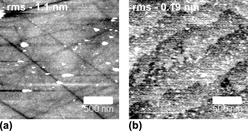Article contents
Argon annealing procedure for producing an atomically terraced 4H–SiC (0001) substrate and subsequent graphene growth
Published online by Cambridge University Press: 30 July 2012
Abstract

The epitaxial growth of graphene on hexagonal silicon carbide polytypes on both the silicon-terminated (0001) and carbon-terminated ( $000\bar 1$) faces has shown promise in the development of large area graphene production. It is important during these growth procedures to ensure that the underlying silicon carbide substrate is well ordered before the graphene growth. Regularly, this involves the use of a hydrogen etching procedure before graphene growth to remove polishing scratches and other defects from the substrate surface. Here, we present evidence that annealing silicon carbide substrates in argon gas at atmospheric pressure suppresses the onset of graphitization up to a temperature of 1500 °C and allows for regularly stepped terraces and removes surface defects. This allows substrate preparation and subsequent graphitization (by increasing the annealing temperature) to be carried out within a single process under an inert gas atmosphere.
$000\bar 1$) faces has shown promise in the development of large area graphene production. It is important during these growth procedures to ensure that the underlying silicon carbide substrate is well ordered before the graphene growth. Regularly, this involves the use of a hydrogen etching procedure before graphene growth to remove polishing scratches and other defects from the substrate surface. Here, we present evidence that annealing silicon carbide substrates in argon gas at atmospheric pressure suppresses the onset of graphitization up to a temperature of 1500 °C and allows for regularly stepped terraces and removes surface defects. This allows substrate preparation and subsequent graphitization (by increasing the annealing temperature) to be carried out within a single process under an inert gas atmosphere.
- Type
- Articles
- Information
- Journal of Materials Research , Volume 28 , Issue 1: Focus Issue: Silicon Carbide – Materials, Processing and Devices , 14 January 2013 , pp. 1 - 6
- Copyright
- Copyright © Materials Research Society 2012
References
REFERENCES
- 6
- Cited by




